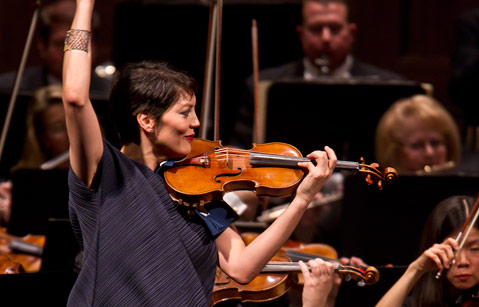The S.B. Symphony at the Granada Theatre
Anne Akiko Meyers Played Works by Bach, Bloch, Haydn, and Ravel

Maestro Nir Kabaretti came out before the beginning of this concert to speak a few words about how he decides what size of ensemble will be used for each piece on a program. He began by saying that, insofar as they can be known, the composer’s intentions are the first thing consulted. Most of the time they are all that is needed. However, he said, there are always those instances in which the size of the group is not specified, and this is especially common in regard to the strings. As he spoke this, a string ensemble the size of a small chamber orchestra surrounded him, and they remained to play J. S. Bach’s Brandenburg Concerto No. 3 in G Major, BWV 1048. The familiar piece unfurled in exemplary fashion, with concertmaster Caroline Campbell executing the handful of violin solos with an understated elegance entirely suited to the graciousness of the music.
No sooner had they finished the Bach than the stage began to fill with another two or three times as many players, all strings but for the lone pianist, creating what Kabaretti had termed in his remarks a “crowded railway station” effect, but it was not to last. Once settled in for the Concerto Grosso No. 1 for String Orchestra and Piano Obbligato of Ernest Bloch, the orchestra passed from busy movement into purposeful, sustained harmonies. Bloch’s work was written between 1924 and ’25 to prove to his students at the Cleveland Institute of Music that tonality was not dead, and its traditional method and structure both recalled the Bach of moments before and looked ahead to such works as the Symphony No. 83 in G Minor of Joseph Haydn that came in the second half of the program. Kabaretti did an excellent job of knitting together the disparate sections of this 24-minute piece into a coherent whole, and the overall effect was one of mastery and calm. Big and beautiful, but never scary or outrageous, the Bloch composition served to center the entire afternoon on the values of the classical tradition.
Once the audience returned from intermission, Haydn’s Symphony No. 83, known as “The Hen,” proved to be the day’s most pleasing and entirely successful effort. Weaving together the loosely avian passages in the Bach and the Bloch into a charming premonition of Ralph Vaughan Williams’s “The Lark Ascending,” the Haydn offered a properly intelligent point of view from which to hear the subtle echoes and resemblances among the program’s varied artists.
Violinist Anne Akiko Meyers made a rather astounding entrance as she walked onstage looking every bit of the eight-and-a-half-months pregnant that she was as of the concert. A dear friend of the Santa Barbara Symphony and a world-renowned player, Meyers was in fine form for Williams’s “The Lark Ascending,” which sounded particularly dark and deep on her “Molitor” Stradivarius, one of the world’s most sought-after instruments. Taking her time with the piece, which leaves the violinist exposed for long moments as the composition calls for many sustained, unaccompanied notes, Meyers nevertheless pulled it off with consummate artistry. Next up was the Tzigane of Maurice Ravel, a delightful work that puts the techniques associated with Paganini in service to a set of melodies from the world of the gypsies. The soloist dazzled with her confident attacks on the many challenging passages, including some spectacular pizzicato, but Ravel’s brilliant orchestration nearly stole the show. A final callback, with pretty insistent cajoling from Kabaretti, put Meyers back center stage again for an unaccompanied encore of “Over the Rainbow.”



